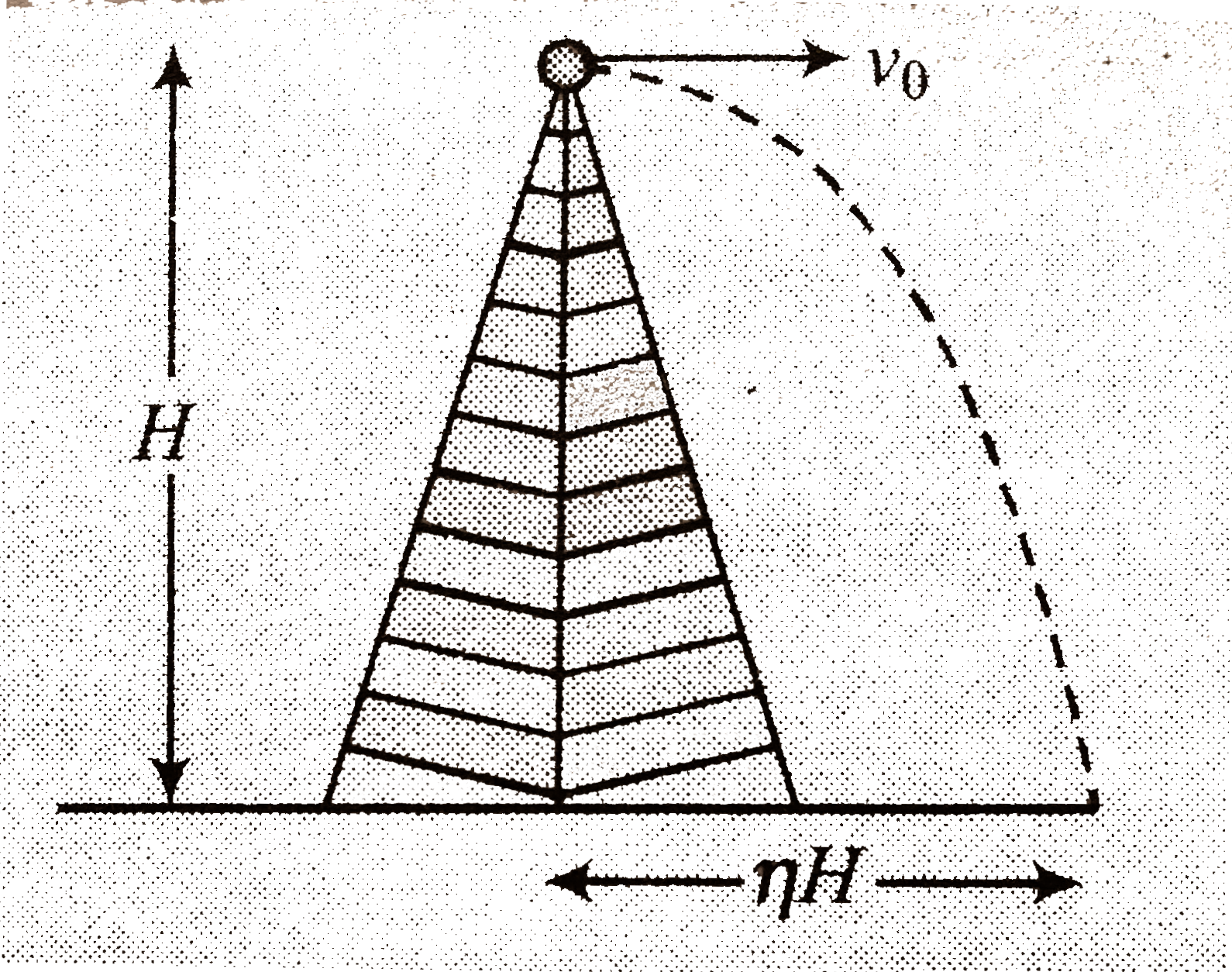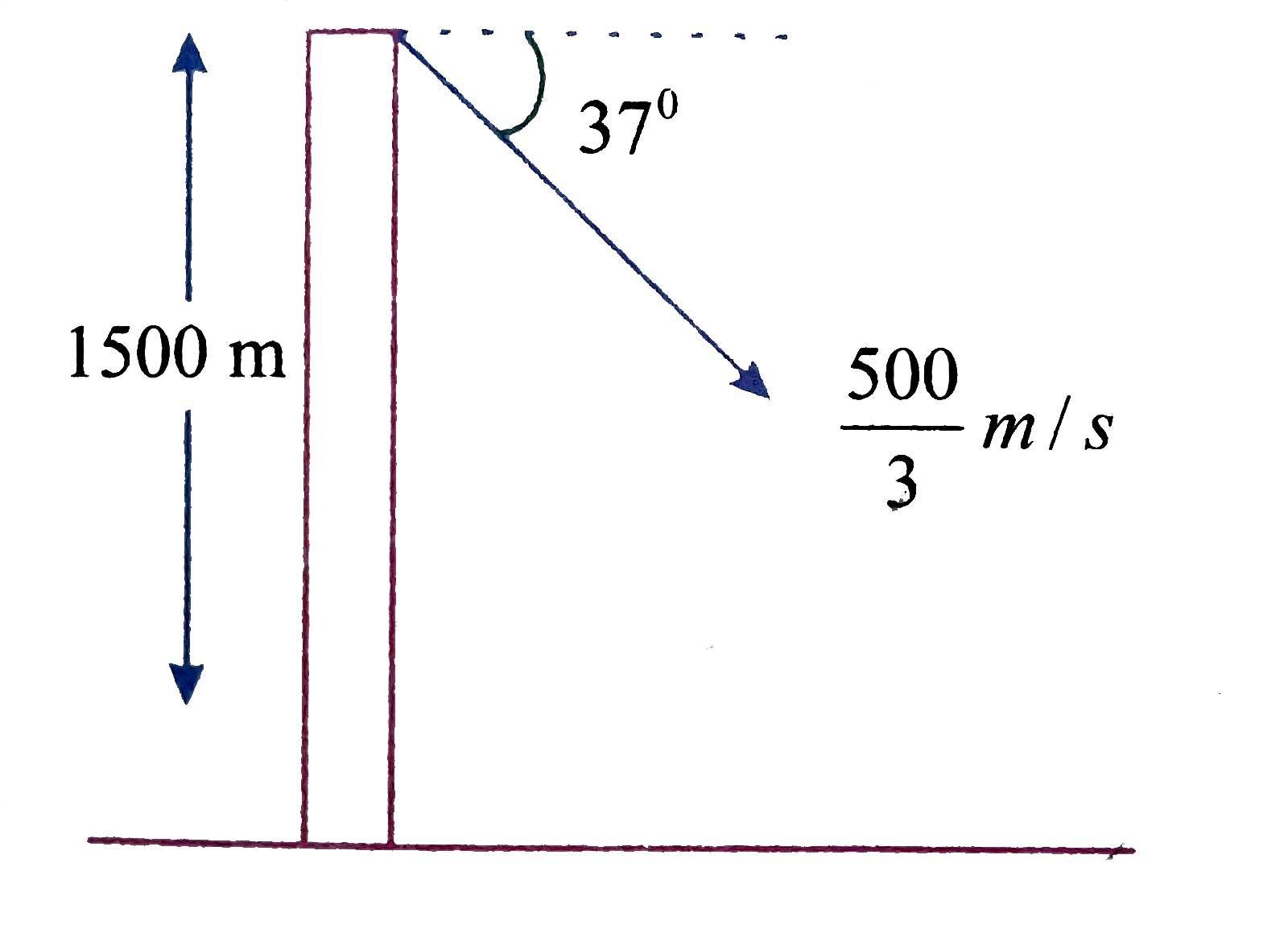An object is projected horizontally from a top of the tower of height h. The line joining the point of projection and point of striking on the ground makes an angle 45∘ with ground, then with what velocity the object strikes the ground
√11gh2
√9gh2
√7gh2
√5gh2
The correct Answer is:C
To solve the problem, we need to find the velocity with which the object strikes the ground after being projected horizontally from the top of a tower of height h. The line joining the point of projection and the point of striking on the ground makes an angle of 45∘ with the ground.
1. Understanding the Problem:
- An object is projected horizontally from a height h.
- The angle between the line of projection and the ground at the point of impact is 45∘.
2. Determine the Time of Flight:
- The time t taken to fall from height h can be calculated using the formula for free fall:
h=12gt2
- Rearranging gives:
t=√2hg
3. Horizontal Motion:
- Let u be the horizontal velocity with which the object is projected.
- The horizontal distance x covered during time t is:
x=u⋅t=u⋅√2hg
4. Using the Angle of Impact:
- Since the angle of impact is 45∘, we know that the horizontal and vertical components of velocity at the point of impact are equal.
- The vertical component of velocity vy just before striking the ground can be calculated using:
vy=gt=g⋅√2hg=√2gh
- The horizontal component of velocity vx is equal to the initial horizontal velocity u.
5. Setting Up the Equation:
- Since the angle is 45∘, we have:
vy=vx
- Therefore:
√2gh=u
6. Finding the Resultant Velocity:
- The resultant velocity v when the object strikes the ground can be calculated using Pythagoras' theorem:
v=√v2x+v2y=√u2+(2gh)=√u2+2gh
- Substituting u=√2gh:
v=√(√2gh)2+2gh=√2gh+2gh=√4gh=2√gh
7. Final Velocity:
- To find the final expression, we need to consider the total energy or kinematic equations. Using the kinematic equation:
v2=u2+2gh
- Since we have u2=gh2:
v2=gh2+2gh=gh2+4gh2=5gh2
- Thus:
v=√5gh2
Conclusion:
The velocity with which the object strikes the ground is:
v=√5gh2
- An object is projected horizontally from a height h.
- The angle between the line of projection and the ground at the point of impact is 45∘.
- The time t taken to fall from height h can be calculated using the formula for free fall:
h=12gt2
- Rearranging gives:
t=√2hg
- Let u be the horizontal velocity with which the object is projected.
- The horizontal distance x covered during time t is:
x=u⋅t=u⋅√2hg
- Since the angle of impact is 45∘, we know that the horizontal and vertical components of velocity at the point of impact are equal.
- The vertical component of velocity vy just before striking the ground can be calculated using:
vy=gt=g⋅√2hg=√2gh
- The horizontal component of velocity vx is equal to the initial horizontal velocity u.
- Since the angle is 45∘, we have:
vy=vx
- Therefore:
√2gh=u
- The resultant velocity v when the object strikes the ground can be calculated using Pythagoras' theorem:
v=√v2x+v2y=√u2+(2gh)=√u2+2gh
- Substituting u=√2gh:
v=√(√2gh)2+2gh=√2gh+2gh=√4gh=2√gh
- To find the final expression, we need to consider the total energy or kinematic equations. Using the kinematic equation:
v2=u2+2gh
- Since we have u2=gh2:
v2=gh2+2gh=gh2+4gh2=5gh2
- Thus:
v=√5gh2
The velocity with which the object strikes the ground is:
v=√5gh2
Topper's Solved these Questions
- APPENDICES (REVISION EXERCISE)BOOK - AAKASH SERIESCHAPTER - APPENDICES (REVISION EXERCISE)EXERCISE - LAW OF MOTION
128 Videos
- APPENDICES (REVISION EXERCISE)BOOK - AAKASH SERIESCHAPTER - APPENDICES (REVISION EXERCISE)EXERCISE - MOTION IN A STRAIGHT LINE
59 Videos
- APPENDICES ( REVISION EXERCISE )BOOK - AAKASH SERIESCHAPTER - APPENDICES ( REVISION EXERCISE )EXERCISE - REVISION EXERCISE (MAGNETISM AND MATTER )
52 Videos
- ATOMSBOOK - AAKASH SERIESCHAPTER - ATOMSEXERCISE - PRACTICE EXERCISE
21 Videos
Similar Questions
A ball is projected horizontally from the top of a building 19.6 m high. If the line joining the point of projection to the point where it hits the ground makes an angle of 45∘ to the horizontal, the initial velocity of the ball is
View SolutionFrom the the top of a tower 19.6 m high, a ball is thrown horizontally. If the line joining the point of projection to the point where it hits the ground makes an angle of 45∘ with the horizontal, then the initial velocity of the ball is:-
View SolutionA body is projected horizontally from the top of a tower with a velocity of 10m/s. If it hits the ground at an angle of 45∘, the vertical component of velocity when it hits ground in m/s is
View SolutionA body is thrown horizontally from the top of a tower. It reaches the ground after 4s at an angle 45° to the ground. The velocity of projection is
View SolutionA body is projected horizontally from the top of a tower with a velocity of 10m/s.If it hits the ground at an angle 45∘, then vertical component of velocity when it hits ground in m/s is
View SolutionA body is projected horizontally from the top of a tower with initial velocity 18ms−1. It hits the ground at angle 45∘. What is the vertical component of velocity when it strikes the ground ?
View Solution(a) With what velocity (v0) should a ball be projected horizontally from the top of a tower so that the horizontal distance on the ground is ηH, where H is the height of the tower ?
(b) Also determine the speed of the ball when it reaches the ground.
 .
.
View SolutionA ball is thrown vertically upwards from the top of tower of height h with velocity v . The ball strikes the ground after time.
View SolutionA ball is projected horizontally with a speed v from the top of the plane inclined at an angle 45∘ with the horizontal. How far from the point of projection will the ball strikes the plane?
View SolutionA particle is projected from a tower as shown in figure, then find the distance from the foot of the tower where it will strike the ground. (g=10m/s2)

View Solution
